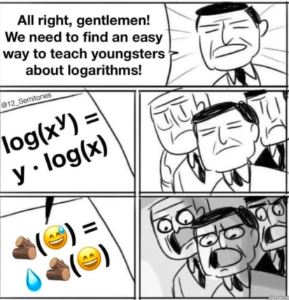Log rules (AA SL 1.7, AI HL 1.9)
Keywords
| English | Japanese | Korean | Chinese Simplified |
| Logarithmic Rules | 対数法則 | 로그 규칙 | 对数规则 |
| Base Change Rule | 底の変換規則 | 밑변환 법칙 | 底数变换规则 |
| Simplifying Expressions | 式の簡素化 | 표현식 단순화 | 简化表达式 |
| Exponential Equations | 指数方程式 | 지수 방정식 | 指数方程 |
| Logarithmic Equations | 対数方程式 | 로그 방정식 | 对数方程 |
| Indices Rules | 指数法則 | 지수 규칙 | 指数规则 |
| Natural Logarithm, ln | 自然対数 | 자연로그 | 自然对数 |
Inquiry questions
Factual Inquiry Questions
| Conceptual Inquiry Questions
| Debatable Inquiry Questions
|

Mini-Investigation: Discovering Logarithmic Rules
Objective:
Use the interactive applet provided to explore and uncover the fundamental rules of logarithms. This investigation will guide you through a series of steps to understand how logarithms work and how their properties are applied.
Investigation Steps:
Step 1: Discovering the Product Rule
- Use the applet to calculate the log of two numbers multiplied together (e.g., ).
- Next, calculate the log of each number separately (log(2) and log(3)) and then add these values together.
- Compare the results. What do you notice? This observation will lead you to the Product Rule of logarithms.
Step 2: Investigating the Quotient Rule
- Repeat a similar process as in Step 2, but this time use division. Calculate the log of a number divided by another (e.g., ).
- Calculate the log of the numerator and the denominator separately ( and ) and then subtract the denominator's log from the numerator's log.
- Observe and note the relationship between these values, leading you to the Quotient Rule of logarithms.
Step 3: Uncovering the Power Rule
- Use the applet to calculate the log of a number raised to a power (e.g., ).
- Calculate the log of the base number () and then multiply it by the exponent ().
- Examine how the calculated log compares to the log of the number raised to a power. This will help you understand the Power Rule of logarithms.
Step 4: Confirming the Base Change Rule
- Experiment with changing the base of the logarithm in the applet.
- Try to express a logarithm of one base in terms of logarithms of another base using the applet's outputs.
Conclusion:
- Summarize the rules you discovered: Product Rule, Quotient Rule, Power Rule, and the Base Change Rule.
- Reflect on how these rules help in simplifying complex logarithmic expressions and in solving logarithmic equations.
Checking understanding of simplifying log expressions
Alternatively these more bite-size videos give worked examples of test style questions.
Indices rules - This is basic but incredibly important skill that is used later in calculus https://youtu.be/TOXhuEoEi44, Exponentials - Exponential equations (hidden quadratic) , https://youtu.be/12BD5yk4zso , Logarithms https://youtu.be/C2f5NvtMCoU , Natural log - ln(x) , https://youtu.be/dl7mOHtOKu4 Using logs to find unknown powers , https://youtu.be/7sBzT9XdDdo
Simplify:
Simplify
Simplify
Simplify
Part 3 - Testing your understanding using exam-style questions
Testing your understanding using exam-style questions
![[MAA 2.9] LOGARITHMS.pdf](https://stage.geogebra.org/resource/edtbasvb/DRkSqT8DoFUk4xyO/material-edtbasvb-thumb.png)
![[MAA 2.9] LOGARITHMS_solutions.pdf](https://stage.geogebra.org/resource/w5ysqjav/I9CLmV2Ex3VfzHZO/material-w5ysqjav-thumb.png)
